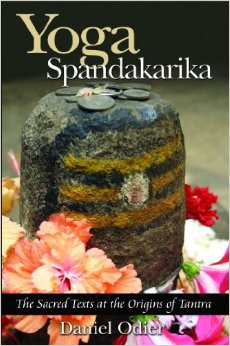The Sacred Tremor That Frees Our Hearts
to Love

recitations and commentaries on Daniel Odier's Yoga Spandakarika
a 52-session audio course by Saniel Bonder with additional video material
It's our deep pleasure to offer you this unique audio experience. "The Sacred Tremor That Frees Our Hearts to Love" audio course is an inspiring 52 hours contemplating one of the finest collections of ultimate wisdom on realized living available in our time.
In his book Yoga Spandakarika, Daniel Odier, a contemporary tantric master based in France, provides a superlative commentary on the Spandakarika, or "Song of the Sacred Tremor," of Vasugupta, one of the earliest texts of Kashmir Șaivism. Subtitled The Sacred Texts at the Origins of Tantra, Yoga Spandakarika features resonant excerpts from the tantric teachings of many Tibetan Buddhist, Kashmir Șaivite, and Ch'an (Chinese Zen) adepts, some well known and some quite obscure. It's a feast for liberating understanding and liberated practice, for perceiving and participating in every ordinary moment, positive or negative, as itself an occasion of ultimate reality and and most sacred grace.
Saniel was toying with the idea of a year-long course but hadn't quite committed to it. At one point during the 2014 "In the Heat of the Heart-Transmission" retreat in Chicago, he read aloud and offered reflections on a few paragraphs of Yoga Spandakarika. Doug Morris, formerly a longtime Vajrayana Buddhist practitioner and now the new Waking Down Chicago area coordinator, spontaneously urged Saniel to comment on and record the whole book. Since that was exactly what he had felt moved to do, Saniel took Doug's inspiration as a clear "YES!" to go forward with this new kind of course.
First two sessions: our gift to you
We're offering the first two recorded sessions of this course as gifts to you so you can determine if you'd like to register for the whole course. If you find these recordings intriguing, register for the course here.Here are the two gift sessions, followed by a personal message from Saniel, the course syllabus and registration information.


and The Human Sun Institute Team
"The Sacred Tremor That Frees Our Hearts to Love" audio presentations

Session #1: Introduction
In this session, Saniel discusses Odier's autobiographical preface, a brief chapter presenting the history of Spandakarika and certain tantric practices related to it, and gives a recitation of the full 52 stanzas of the text.
Session #2: First stanza of the "Song of the Sacred Tremor"
In this session, Saniel gives a more exemplary experience of these recitations and commentaries. The session discusses Stanza 1 of the "Song of the Sacred Tremor" and its version of the three additional elements Odier devotes to the commentary on each stanza (or, in some cases, each cluster of two or three stanzas): first a written exposition by himself, then a quotation from a great Kashmir Șaivite, Tibetan Buddhist, or Ch'an adept, then a transcription of a further, originally oral commentary again by Odier.Message from Saniel
Dear Friend,
Now that I've had a chance to record the "The Sacred Tremor That Frees Our Hearts to Love," I have to say I'm in love with this project. I hope the free sessions give you a bit of a feeling for the scope and depth of what we are exploring here.
As you'll hear in my initial commentaries, I have tremendous respect and gratitude for what Daniel Odier accomplishes in this book. I have never before encountered teachings that so consistently resonate with the wisest understandings of the nature of life and how to live it that I've been able to find myself. In my commentaries I try to clarify both these resonances and also those particular ways in which I am inclined to see, hold, or articulate things somewhat differently.
Thus, doing this project is for me a wonderful exercise in both deep appreciation and some of the most profound discernment I can muster. I hope you will find it greatly helpful for your own further growth, clarification, and transformation as well.
With all my heart, I welcome you to join me on this journey. May we each and all only and always grow in our capacity to embody what Daniel Odier learned from a Ch'an monk, Master Kosen, as "harmony with the cosmos."
Blessings,

Course syllabus
As he's done in the first two gift sessions, Saniel simply recites the entire text of Yoga Spandakarika in the order it appears, offering his own additional commentary to Daniel Odier's as he is moved. Saniel recites and comment on the Spandakarika text and Odier's book in the following order:-
The text of the Spandakarika of Vasugupta, which is divided into three "flows":
- First Flow (Stanzas 1-16) – "The Instructions Concerning the Independent Existence of the Self"
- Second Flow (Stanzas 17-27) – "The Direct Perception of One's Own Fundamental Nature"
- Third Flow (Stanzas 28-52) – "The Universal Nature Reflected in the Power of One's Own Nature"
-
The substantial "songs" with which Odier concludes each flow:
- "Mind, Empty Like Space," by the great 11th century C.E. Tibetan Buddhist yogini Machig Labdron
- "Self-Liberation Through Seeing with Naked Awareness," by Padmasambhava, the legendary, supreme adept who brought the transmission of Mahamudra to Tibet in the 8th century
- "The Union of Joy and Emptiness," by Tilopa, the 9th century Kashmiri founder of what became, through Naropa and then Marpa and Milarepa, the Kagyu lineage of Vajrayana Buddhism in Tibet
- Odier's conclusion, "Should One Practice Mahamudra?"
-
Odier's two appendices:
- a translation of the Vijnanabhairava Tantra
- "The Natural Vision through Naked Vision, Identifying Intelligence," an alternative translation of Padmasambhava's song that concludes the Second Flow.
How to Download and Burn CDs of these Audios
In addition to listening to the recordings on this web page, you can download them onto your computer:
To Download- Right-click (or control-click on a single-button Mac mouse) on the DOWNLOAD button for the Broadband or Dial-Up link of choice (if Broadband or Dialup is not specified, only the lower resoultion Dialup version is available).
- Select Save Target As... or similar menu item.
- Finally, select a destination on your hard drive (the Desktop, for example) and begin the download.
You can create Audio CDs from these recordings for playback on any conventional CD player. A single audio-CD formatted disc can hold one of Saniel’s hour-long Broadband recordings.
To Burn Audio CDs- First right-click the DOWNLOAD button for the Broadband (higher quality if available) or Dialup (lower quality) files.
- Then launch your CD authoring software (common programs are Ahead Nero on Windows, Toast on Macs, and iTunes on both platforms).
- Select Audio CD as the result and choose the downloaded MP3 files as the source audio file.
- Most audio-CD authoring software will automatically convert files to the correct sampling rate, though some do not. If possible, ensure that your software is set to create audio-CDs at 44.1kHz / 16 bit resolution. Otherwise, the CD may sound garbled on playback.
- With a blank CD in the drive, create an Audio CD. Your software will automatically convert the MP3 file to the proper format for playing in your car, home, or portable stereo Audio-CD player.
Many newer car, home, and portable CD/DVD players are equipped to play longer-playing MP3 CDs. Such players often display an "MP3" icon. The advantage of MP3 format is that several Broadband files can be fit on a single disc.
To Burn MP3-CDsAn MP3-format CD is essentially a CD-ROM or data CD which contains MP3 files. To create a MP3-CD format disk, follow the instructions for audio CD, except select the MP3-CD or Data CD option in your CD authoring software instead of Audio CD. Choose the downloaded MP3 files as the source data and burn the disc.
Copyright ©2014 Saniel Bonder. All Rights Reserved